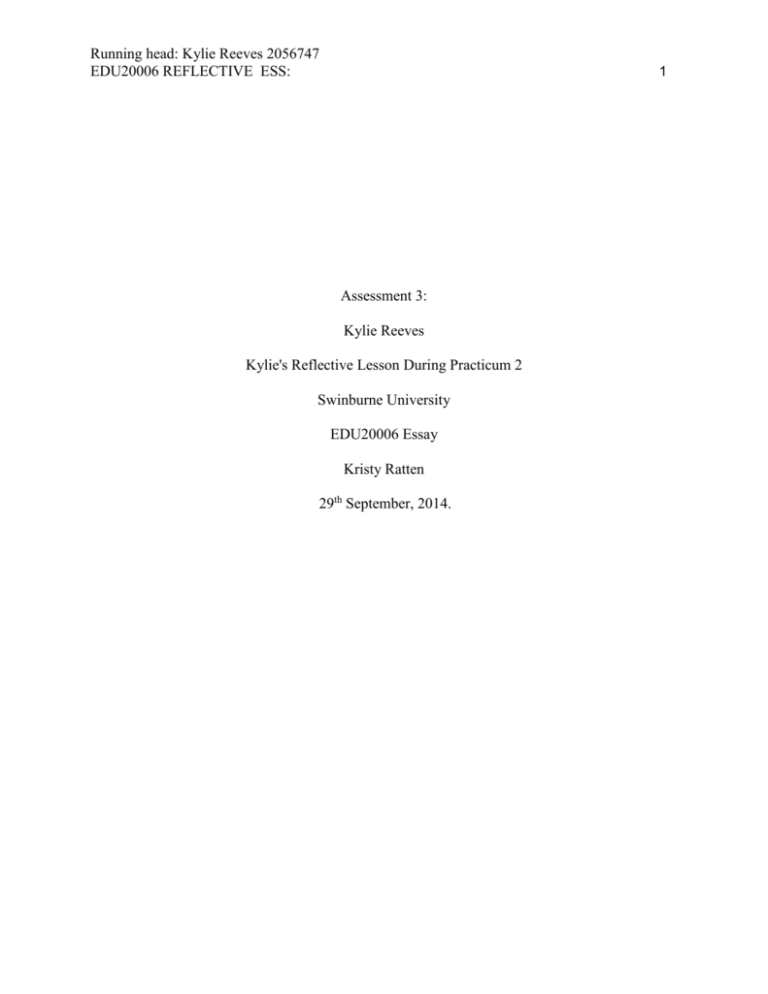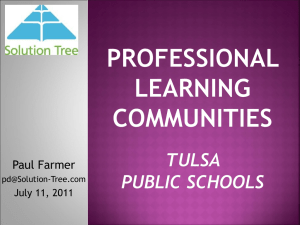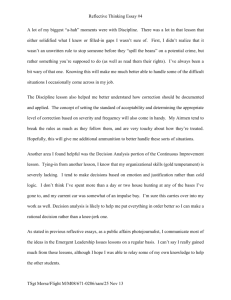My reflection after EDU20006 Practicum 2. at
advertisement

Running head: Kylie Reeves 2056747 EDU20006 REFLECTIVE ESS: 1 Assessment 3: Kylie Reeves Kylie's Reflective Lesson During Practicum 2 Swinburne University EDU20006 Essay Kristy Ratten 29th September, 2014. Running head: Kylie Reeves 2056747 EDU20006 REFLECTIVE ESS: 2 It was the last day, and I was eating party food with the children at my farewell do. I was ready to collapse, but sad to be finishing up the practicum. This reflective essay critically examines the strengths and challenges that were practised during Practicum 2 for EDU20006. Strengths such as enthusiasm, effort and organisation are highlighted with examples of how they developed my teaching skills. Class control is identified as the main challenge, with ongoing development and links to the National teaching standards. Relationships with my mentor, staff, students and, parents are discussed. Strategies and insight into how they were developed are articulated, covering issues such as empathy, support, acceptance and creating a safe environment. Curriculum and assessment are explored, and how they guide and impact teaching and learning. Looking at specialist classes, whole-school citizenship and, how my mentor addressed curriculum needs are identified. In terms of assessment, prior knowledge, questioning, observation, as well as varied evaluation tools, in relation to multiple ways of learning are discussed. Freedom, creativity, teaching-aides, self evaluation and feeling prepared, show an indepth look at lesson planning. While some Codes of Conduct for teaching have been identified throughout the paper, there is a final look a Principle 1.1, Relationships with students, where diversity and providing differentiated learning opportunities are highlighted with supportive literature. Strengths: Enthusiasm, effort and organisation I made a conscious effort to be enthusiastic and positive as a student teacher, and future educator. One example of this, was when the children were having their parents day concert, I got involved in the excitement and helped by bringing in some costumes. I also applied this enthusiasm Running head: Kylie Reeves 2056747 EDU20006 REFLECTIVE ESS: 3 outside of my teaching agenda. For example, I organised a making Dinosaurs lesson at my mentors request, putting in effort to organise and implement the activity with the children. (Reeves, Parents Day, September 11, 2014). (Reeves, Making Dinosaurs, September 5, 2014 I wanted to demonstrate that I was open suggestion, and to be helpful and supportive. Looking back, I believe I wanted to convey that attitude because it communicated that I had the right priorities in place as an educator, the children. Blaise(cited in Latham, Blaise, Dole, Faulkner & Malone, 2011) highlight that understanding why you are entering education will help shape one's philosophy and the kind of teacher one becomes. I knew I was there to create positive learning experiences with children. Challenges: Class management My first lesson at the specialist school left me feeling out of control. I tried my mentors strategies and made a turn-taking aide, but new issues would arise. After being out of my depth on a regular basis, I realised it would always be chaotic and I had to be one step ahead. I had to resolve conflict early, using my mentors reward chart. The students quarreled over who was first, so fairness had to be addressed. For example, making sure everyone was first at something. Burden (2010) says that catering for student diversity and difficulties during a lesson is one of Running head: Kylie Reeves 2056747 EDU20006 REFLECTIVE ESS: 4 hardest parts of teaching. While the children had mild additional needs, reactions were explosive and they disengaged quickly. The AITSL (2014) explains graduate teachers need strategies to support full participation of students with a disability. I had to work at this constantly. (D' Souza, Rewards Chart, September 15, 2014). Relationships Mentor I was uncertain how I would be received by my mentor, due to our differences. She was methodical, forthright, and firm. We set goals for my university requirements, along with many additional tasks. I came home and cried after week one because I felt overloaded and underappreciated. A wise person said that a professional can work with someone that is polar opposite and learn from them. Churchill & Keddie (cited in Churchill, Ferguson, Godinho, Johnson, Keddie, Letts, Mackay, McGill, Moss, Nagel, Nicholson & Vick 2013) highlight that partnerships with colleagues is imperative in education. I continued being open, grateful, helpful and listening to constructive criticism. My Mentor saw my dedication after my first lesson and shared her grueling practicum experiences in India. I realised the influences on her work ethic. Gibson (2010) explains, that developing good interpersonal skills with colleagues requires empathy about others perspectives. Running head: Kylie Reeves 2056747 EDU20006 REFLECTIVE ESS: 5 I gained teaching strategies from someone with 25 years experience and my perceived limits were stretched. Staff I introduced myself to most of the eighty plus staff. They were kind and supportive, so I reciprocated it. I attended social club to support a staff members' efforts. Churchill & Keddie (2010) say educators should create a supportive teaching culture. A fellow Swinburne student and I also formed a supportive partnership. I helped one staff member with his Perceptual Motor Program [PMP], by bringing in hats for a crazy hat game on the last week of term. The Victorian Code of Conduct, principle 1.8, b., states educators should support colleagues, and in particular with graduates (Victorian Institute of Teaching, 2010) [VIT]. The staff were asking when I finished my degree, so I could work there. Students and families Connections made with students developed at their comfort levels. Getting to know them and their interests helped. One student struggled with change and with me being there. We both often arrived early, and he would hide under the table. I suggested he could get out the magnets he liked until his teacher arrived. By the end of the practicum, he was saying "Please don't go!". McDonald (2010) says educators need to provide an environment where students feel safe and accepted. It felt rewarding that to have students put trust in me. I often arrived early, and was there to greet the parents of a morning. This was a good icebreaker, and I learned their names to be personable. I sent permission forms home to use photos Running head: Kylie Reeves 2056747 EDU20006 REFLECTIVE ESS: 6 in a lesson, and in appreciation, I made the lesson involve a book that the children could take home. Under AITSL's (2011) Professional Standard 7.3, I believe I made effort to work with parents sensitively and respected confidentiality rights. On the last day some parents hugged me and wished me luck. Curriculum and assessment The principal of the specialist school mentioned that very few schools in Victoria provide a rich, specialist program with whole-school citizenship like theirs. I got to experience specialist classes such as Cooking, Music and Movement, Dance, Singing, Drama, Information Communications Technology [ICT], Physical Education, PMP, Speech Therapy and Art. Nicholson (2013) says that a curriculum that gives all students' abilities the opportunity to thrive, is providing an inclusive classroom. It was a rich and diverse curriculum. I saw whole-school citizenship every Tuesday and Friday, with junior and whole school assembly. The assemblies included individual achievement awards, sports scores, Birthdays' and the senior music students performed songs. I witnessed the dedication in providing a motivating curriculum, with strong role models. They promoted 'Kindness week' and on the second last day of term, the principal and assistant principals participated in the ice bucket challenge. The Victorian Institute of Teaching (2010)states that educators must be positive role models and have high expectations of every student. It was evident that the school celebrated achievements and created whole-school support. Running head: Kylie Reeves 2056747 EDU20006 REFLECTIVE ESS: 7 I observed and participated in Literacy, Numeracy, Science, Drama and ICT sessions, as well as other learning areas that my mentor thought the children should focus on, such as emotions or turn-taking. I found it insightful how general capabilities were included in a learning area. For example, presenting a picture of something and incorporating counting, speaking, comprehension and so forth into the lesson. The Australian Curriculum highlight that students should have general capabilities cross over into various learning areas to provide best curriculum (ACARA, 2013). I looked at students work books, observed their capabilities, and spoke to my mentor so that I could set realistic goals and connect prior knowledge for each child. Duchesne, McMaugh, Bochner, & Krause (2013) say that educators should be able to evaluate what prior knowledge students have to aid the lesson planning process I used mainly formative assessment, where I assessed students knowledge using questioning, observing and documenting, during writing tasks, ICT, cutting and pasting, as well as worksheet templates for their workbooks, going into summative portfolios. I included various ways to assess and evaluate, to provide quality assessment of children's unique learning styles. Gardner (1997) says great teachers provide students with multiple ways to demonstrate their understanding (Edutopia, 2014). Running head: Kylie Reeves 2056747 EDU20006 REFLECTIVE ESS: 8 (Reeves, K, Worksheets for Summative portfolio, September 1, 2014). Planning Lessons Apart from feeling stressed for time, I enjoyed exploring both AusVELS (n.d) and ACARA(2013) to guide the lesson planning process. I believe this was another one of my strengths. I recall my mentor asking me if I was sure I had never taught primary students before, after my Counting Dinosaurs lesson. Looking back, I believe I enjoyed it because it gave me freedom to express personal values and creativity. Selecting what sort of resources to use such as ICT, concrete objects, writing, games, and also making resources was enjoyable. Marsh (2010) points out that lesson planning is an avenue for teachers to introduce and share values and content they believe are important. I liked having framework as a guide, but delivering it how I thought best. Running head: Kylie Reeves 2056747 EDU20006 REFLECTIVE ESS: 9 (Reeves, Children Enjoying a Seasons Lesson, September 10, 2014). I thought that preparing the rationale, learning objectives, teaching strategies, assessment strategies, and breaking up the lessons into stages, were brilliant ways to feel mentally prepared. It helped me to examine what I what I was going to teach and why, how to teach it, and what tools (strategies) I could bring to keep the children focused. For example, I had to focus on voice modulation and rewards. I liked making and trying out my own teaching aides, such as a counting pointer and turn-taking stars, as well as setting up the physical environment. Kerry, (2010) says that planning for learning is a way to put your mental rehearsal onto to paper. I really enjoyed all aspects of creating my plan in the lesson template. The AITSL (2014) professional teaching standards 2.2, state that educators must know how to organise content into an effective learning plan. I believe I demonstrated this ability through my lesson planning, during assessments, and during weeks three and four, where I took on 0.4 of teaching duties. Running head: Kylie Reeves 2056747 EDU20006 REFLECTIVE ESS: 10 (Reeves, Kylie's Pointer, September 1, 2014). I saw value in self evaluation, reflecting on what was appealing to the children and, if they understood and could demonstrate their understanding. Killen (2013) illustrates that reflection on practice helps teachers break up how well received their lesson was, determine strengths and, brainstorm ways to improve or change their lesson to achieve best outcomes. Code of Conduct in practice While I have mentioned a few principles under the code of conduct for VIT (2010), one worth elaborating on is Principle 1.1, Relationships with Students. Teachers provide opportunities for all students to learn, a. Knowing their students well, respecting their individual differences and catering for their individual abilities (cited in VIT, 2010). I believe I practised this code through my caring and gentle disposition towards the students, and I made all children feel appreciated for who they were. I am a strong believer in celebrating people's differences and this is a large part of why I organised my placement in a specialist setting. For example, I got to know each child very well and celebrated their unique milestones. For example, for one child, even just saying 'Good morning' during the 'Weekend news' was an achievement, and I congratulated the child's efforts. McDonald (2010) points out that it is an educators role to help children see their differences as strengths and empower them to have self acceptance. Upon reflection, I also see that I was addressing code 2.1, through my planning and implementing of lessons. For example, during literacy lesson and mathematics lessons, I applied differentiated instruction to cater for varying abilities. During one of my literacy lessons, I Running head: Kylie Reeves 2056747 EDU20006 REFLECTIVE ESS: 11 instructed a student who could read, to read aloud during group circle. For those who struggled, I focused on single words. During an addition lesson, I gave appropriate sums to each child, smaller units for one child, and harder sums for those at a higher level of mathematics. Brookhart (2008) says educators should met the varied needs of students through personalised instruction, and it is realised that all children have unique needs. This reflective essay has identified enthusiasm, effort and organisation as strengths of mine during the practicum. Class control was the main challenge, and is an ongoing skill to work on. Relationships with my mentor, staff, students and families are delved into, with strategies such as empathy, support, acceptance and safety identified. The curriculum is examined and specialist classes, whole-school citizenship and meeting curriculum needs were explored. For assessment, prior knowledge, questioning, observation, and using multiple evaluation tools were used. Lesson planning is discussed and it is identified that freedom, creativity and feeling prepared are its gains. The Codes of Conduct were mentioned throughout the paper, but Principle 1.1, Relationships with students is examined closely, and experiences of celebrating diversity and applying differentiated learning are shared and examined critically. Running head: Kylie Reeves 2056747 EDU20006 REFLECTIVE ESS: 12 References Australian Curriculum and Assessment Reporting Authority (2013). Curriculum. Australia: Education Services Australia. Retrieved from http://www.australiancurriculum.edu.au/CrossCurriculumPriorities/Sustainability Australian Curriculum and Assessment Reporting Authority (2013). Curriculum. General Capabilities. Australia: Education Services Australia. Retrieved from http://www.acara.edu.au/curriculum/general_capabilities.html Australian Institute for Teaching and School Leadership. (2014). 1.6 Strategies to support full participation of students with a disability. Australian Professional Standards for Teachers. Retrieved from http://www.aitsl.edu.au/australian-professional-standards-forteachers/standards/list?s=1 Blaise, M. (2011). Teachers theory making In G. Latham, M. Blaise, S. Dole, J. Faulkner & K. Malone (Eds.), Learning to teach: New times, New practices (Vol. 2, pp. 105157). South Melbourne Oxford University Press. Burden, P. R. (2010). Classroom management: creating a successful K-12 learning community. Hoboken, NJ: John Wiley & Sons. Churchill, R., & Keddie, A. (2013) In R. Churchill, P. Ferguson, S. Godinho, N. Johnson, A. Keddie, W. Letts, J. Mackay, M. McGill, J. Moss, M. Nagel, P. Nicholson & M. Vick (Eds.),Teaching making a difference (Vol. 2, pp. 537). Milton, QLD: Wiley Publishing. D' Souza, J. Rewards Chart. [photograph]. Retrieved September 15, 2014. Duchesne, S., McMaugh, A., Bochner, S., & Krause, K. (2013). Educational psychology for learning and teaching (4th Edn.). South Melbourne, Vic: Cengage Learning Australia. Running head: Kylie Reeves 2056747 EDU20006 REFLECTIVE ESS: 13 Edutopia (September 26, 2014). Big Thinkers: Howard Gardner on Multiple Intelligences [video file]. Retrieved from http://www.edutopia.org/multiple-intelligences-howard-gardnervideo#graph6 Gibson, R. (2010). 'Helping pre-service teachers learn to communicate effectively'. In Ewings, R., Lowrie, T., & Higgs, J. (Eds). Teaching & communicating: rethinking professional experiences (pp 94-103). South Melbourne: Oxford University Press. Kerry, T(2010). Cross-Curricular Teaching in the Primary School : Planning and Facilitating Imaginative Lessons. UK: Taylor and Francis. Retrieved from http://www.eblib.com Killen, R. (2013). Effective teaching strategies: lessons from research and practice (6th Edn.). McDonald, T. (2010). Classroom management: engaging students in learning. South Melbourne: Oxford University Press. Nagel, M. (2013). Student learning. In R. Churchill, P. Ferguson, S. Godinho, N. Johnson, A. Keddie, W. Letts, J. Mackay, M. McGill, J. Moss, M. Nagel, P. Nicholson & M. Vick (Eds.),Teaching making a difference (Vol. 2, pp. 74-88). Milton, QLD: Wiley Publishing. Nicholson, P. (2013). 'Organising the learning environment'. In Churchill, R. (Eds). Teaching: making a difference (pp. 297-318). Milton, QLD: John Wiley & Sons. Victorian Curriculum and Assessment Authority.[AusVELS]. (n.d). Foundation level. Australia: State Government Victoria. Retrieved from http://ausvels.vcaa.vic.edu.au/Foundationlevel Victorian Institute of Teaching. [VIT] (2010). Read the Code of Conduct. Retrieved from http://www.vit.vic.edu.au/conduct/victorian-teaching-profession-code-ofconduct/Pages/ReadtheCode.aspx







